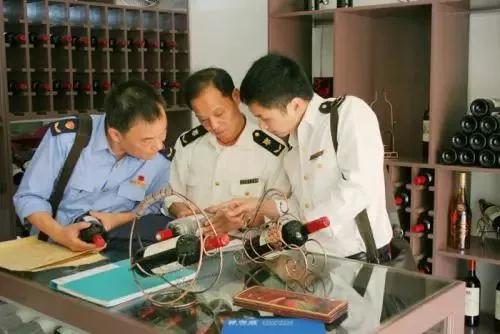Five Problems that Importers and Wineries Should Not Touch

Write | WBO Morris
Translate and Edit | WBO Hersy
Since 2018, many law enforcement departments in China have put forward "promotion action" and "special regulation" on food quality and safety.
Many of these contents involve the wine industry. Which problems should be paid high attention by wine importers and distributors?
AQSIQ recently issued "2018 Quality Supervision, Inspection and Quarantine Points" and vigorously promote "the year of quality improvement action".
Said it will step up supervision and spot checks on daily-use consumer products such as food-related products, intensify law enforcement and counterfeiting of consumer products and step up law enforcement in the field of e-commerce.
For the quality improvement action of law enforcement agencies, especially for counterfeiting, presumably the vast majority of wine practitioners give both hands support.
But WBO also found that in 2017, there are many wines been investigated due to substandard quality or non-compliance documents.
WBO also sort out five categories of "high incidence" of quality and safety in 2017 wine industry, and summed up the relevant solutions for vintners.
Unqualified Packaging
In 2017, the AQSIQ issued a list of unqualified imported wines which were investigated because of unqualified packaging. Unqualified packaging has the highest incidence of events.
WBO had covered the packaging problem in detail in the former article, unqualified packaging generally refers to the carton packaging damage occurred during transportation.
How to solve this problem?
Before delivery, producers can put more cardboard boxes in the container. If packaging damage occurs during the entry, just replace the carton.
Law enforcement agencies will destroy broken wine bottles and contaminated cardboard boxes.
Unqualified Documents
"Cargo and license do not match, unqualified label, and did not provide the required certificate or certificate of conformity", a class of documents belong to the “high incidence” of document problem.
When imported wine applies for quarantine of inspection, contracts, packing list, invoices and other conventional documents are needed, as well as the certificateof origin and the test report if there is it.
And the description of the goods such as name, lot number, quantity, etc. on the documents must be consistent with the actual goods. Otherwise, it will be regarded as non-conformity.
All the labels of wine should be strictly marked according to GB7718-2011 "General Principles of Food Labeling for Pre-packaged Foods".
According to the standard, the back label shall indicate the name of the wine, the list of ingredients, the net content and specification, the name, address and contact details of the producer and / or the distributor, the date of making and the expiry date of the product (wine could not mark the expiry date), storage conditions, production license number, product code and other contents needed to be marked.
The original bottle of imported wine could not mark the food production license number.
Unqualified Physical and Chemical Indicators
In 2017, batches of wines were found to have failed to pass the physical and chemical indicators upon entry.
According to GB15037-2006 "Wine", the dry extract, volatile acids, citric acid, carbon dioxide, iron, copper, methanol, benzoic acid or sodium benzoate, sorbic acid or potassium sorbate of wine in the Chinese market should pass the testing requirements.
For importers, in the procurement of wine, please make sure to ask the supplier to provide the physical and chemical testing reports before order. The testing reports issued by the third testing agencies is the best.
Of course, the test report is only responsible for the sample. Chinese importers in the procurement should choose the producers with a good reputation. Do not just choose the cheap ones.
Unqualified Alcohol Contents
In the field of domestic production and circulation, the unqualified alcohol belongs to the hardest hit. In 2017, there were many cases involved unqualified alcohol investigated by the Food and Drug Administration in China.
According to "Wine" of GB15037-2006, the indication and actual value of alcohol should not exceed ±1.0% (volume fraction); the alcohol content of low-alcohol wine is 1.0% -7.0%(volume fraction); the alcohol content of dealcoholized wine is 0.5 % -1.0%(volume fraction).
It is known that alcohol is an important physical and chemical indicator of alcoholic products.
Unqualified alcohol maybe due to the unstrict control during the production of individual companies or the low level of production technology which cannot effectively control the level of alcohol; may also be individual companies deliberately to mark a high alcohol content in order to reduce costs, raise the price and deceive the consumers.
WBO advice: in the procurement of wine, distributors must choose importers and wineries with a good reputation, and ask for the appropriate test reports.
No Chinese Back Labels
In addition, imported wines without Chinese back labels also occurred in 2017.
According to Article 97 of the "Food Safety Law of the People's Republic of China": Imported prepackaged food and food additives shall be labeled in Chinese.
There shall be a manual in accordance with the law, and a Chinese manual shall also be issued.
According to WBO, sales of wine without a Chinese back label will be punished once the Food and Drug Administration investigated. Except punishment, the products shall be confiscated.
In 2017, WBO reported that a wine dealer was fined for $ 30,000 because of the lacking of Chinese back labels of 8 bottles. WBO also reminds that vintners must eliminate the sales of the unknown wines and wines without Chinese explanations.